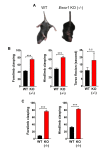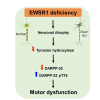Genetic Ablation of EWS RNA Binding Protein 1 (EWSR1) Leads to Neuroanatomical Changes and Motor Dysfunction in Mice
- PMID: 29731676
- PMCID: PMC5934541
- DOI: 10.5607/en.2018.27.2.103
Genetic Ablation of EWS RNA Binding Protein 1 (EWSR1) Leads to Neuroanatomical Changes and Motor Dysfunction in Mice
Abstract
A recent study reveals that missense mutations of EWSR1 are associated with neurodegenerative disorders such as amyotrophic lateral sclerosis, but the function of wild-type (WT) EWSR1 in the central nervous system (CNS) is not known yet. Herein, we investigated the neuroanatomical and motor function changes in Ewsr1 knock out (KO) mice. First, we quantified neuronal nucleus size in the motor cortex, dorsal striatum and hippocampus of three different groups: WT, heterozygous Ewsr1 KO (+/-), and homozygous Ewsr1 KO (-/-) mice. The neuronal nucleus size was significantly smaller in the motor cortex and striatum of homozygous Ewsr1 KO (-/-) mice than that of WT. In addition, in the hippocampus, the neuronal nucleus size was significantly smaller in both heterozygous Ewsr1 KO (+/-) and homozygous Ewsr1 KO (-/-) mice. We then assessed motor function of Ewsr1 KO (-/-) and WT mice by a tail suspension test. Both forelimb and hindlimb movements were significantly increased in Ewsr1 KO (-/-) mice. Lastly, we performed immunohistochemistry to examine the expression of TH, DARPP-32, and phosphorylated (p)-DARPP-32 (Thr75) in the striatum and substantia nigra, which are associated with dopaminergic signaling. The immunoreactivity of TH and DARPP-32 was decreased in Ewsr1 KO (-/-) mice. Together, our results suggest that EWSR1 plays a significant role in neuronal morphology, dopaminergic signaling pathways, and motor function in the CNS of mice.
Keywords: DARPP-32; EWSR1; central nervous system (CNS); dopamine; motor function; neuron.
Figures





Similar articles
-
EWSR1, a multifunctional protein, regulates cellular function and aging via genetic and epigenetic pathways.Biochim Biophys Acta Mol Basis Dis. 2019 Jul 1;1865(7):1938-1945. doi: 10.1016/j.bbadis.2018.10.042. Epub 2018 Nov 24. Biochim Biophys Acta Mol Basis Dis. 2019. PMID: 30481590 Free PMC article. Review.
-
Integrated analysis of omics data using microRNA-target mRNA network and PPI network reveals regulation of Gnai1 function in the spinal cord of Ews/Ewsr1 KO mice.BMC Med Genomics. 2016 Aug 12;9 Suppl 1(Suppl 1):33. doi: 10.1186/s12920-016-0195-4. BMC Med Genomics. 2016. PMID: 27534535 Free PMC article.
-
Caspr3-Deficient Mice Exhibit Low Motor Learning during the Early Phase of the Accelerated Rotarod Task.PLoS One. 2016 Jan 25;11(1):e0147887. doi: 10.1371/journal.pone.0147887. eCollection 2016. PLoS One. 2016. PMID: 26807827 Free PMC article.
-
Uvrag targeting by Mir125a and Mir351 modulates autophagy associated with Ewsr1 deficiency.Autophagy. 2015;11(5):796-811. doi: 10.1080/15548627.2015.1035503. Autophagy. 2015. PMID: 25946189 Free PMC article.
-
Lack of CCR5 modifies glial phenotypes and population of the nigral dopaminergic neurons, but not MPTP-induced dopaminergic neurodegeneration.Neurobiol Dis. 2013 Jan;49:159-68. doi: 10.1016/j.nbd.2012.08.001. Epub 2012 Aug 10. Neurobiol Dis. 2013. PMID: 22922220
Cited by
-
The TAAR1 Agonist PCC0105004 Regulates Amygdala Synaptic Plasticity to Alleviate Anxiety-Like Behaviors in Rats.Pharmacol Res Perspect. 2025 Apr;13(2):e70068. doi: 10.1002/prp2.70068. Pharmacol Res Perspect. 2025. PMID: 40186385 Free PMC article.
-
Pathogenic Genome Signatures That Damage Motor Neurons in Amyotrophic Lateral Sclerosis.Cells. 2020 Dec 15;9(12):2687. doi: 10.3390/cells9122687. Cells. 2020. PMID: 33333804 Free PMC article. Review.
-
EWSR1::ATF1 Translocation: A Common Tumor Driver of Distinct Human Neoplasms.Int J Mol Sci. 2024 Dec 21;25(24):13693. doi: 10.3390/ijms252413693. Int J Mol Sci. 2024. PMID: 39769457 Free PMC article. Review.
-
EWSR1, a multifunctional protein, regulates cellular function and aging via genetic and epigenetic pathways.Biochim Biophys Acta Mol Basis Dis. 2019 Jul 1;1865(7):1938-1945. doi: 10.1016/j.bbadis.2018.10.042. Epub 2018 Nov 24. Biochim Biophys Acta Mol Basis Dis. 2019. PMID: 30481590 Free PMC article. Review.
-
Rationale for Early Detection of EWSR1 Translocation-Associated Sarcoma Biomarkers in Liquid Biopsy.Cancers (Basel). 2021 Feb 16;13(4):824. doi: 10.3390/cancers13040824. Cancers (Basel). 2021. PMID: 33669307 Free PMC article. Review.
References
-
- Bertolotti A, Melot T, Acker J, Vigneron M, Delattre O, Tora L. EWS, but not EWS-FLI-1, is associated with both TFIID and RNA polymerase II: interactions between two members of the TET family, EWS and hTAFII68, and subunits of TFIID and RNA polymerase II complexes. Mol Cell Biol. 1998;18:1489–1497. - PMC - PubMed
-
- Yang L, Embree LJ, Tsai S, Hickstein DD. Oncoprotein TLS interacts with serine-arginine proteins involved in RNA splicing. J Biol Chem. 1998;273:27761–27764. - PubMed
-
- Chansky HA, Hu M, Hickstein DD, Yang L. Oncogenic TLS/ERG and EWS/Fli-1 fusion proteins inhibit RNA splicing mediated by YB-1 protein. Cancer Res. 2001;61:3586–3590. - PubMed
Grants and funding
LinkOut - more resources
Full Text Sources
Other Literature Sources
Molecular Biology Databases
Research Materials

